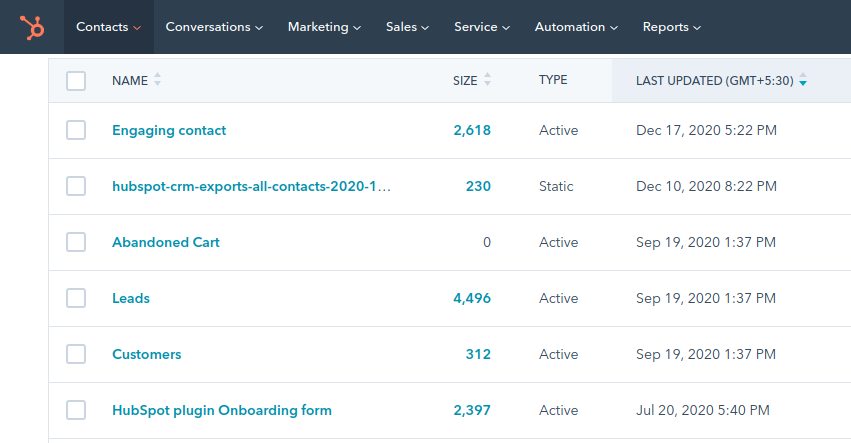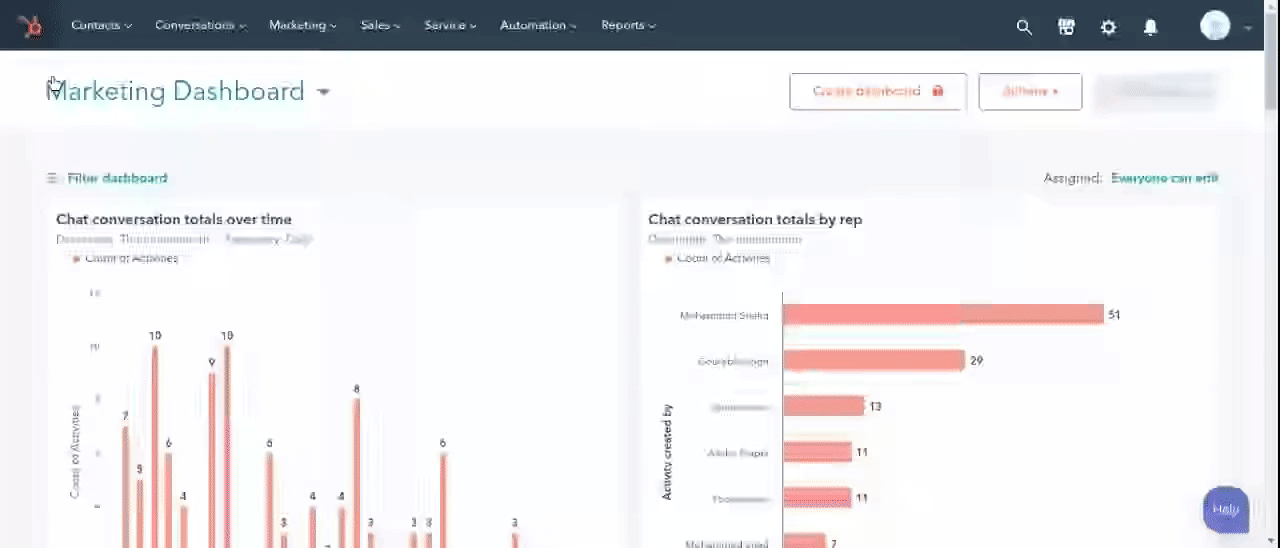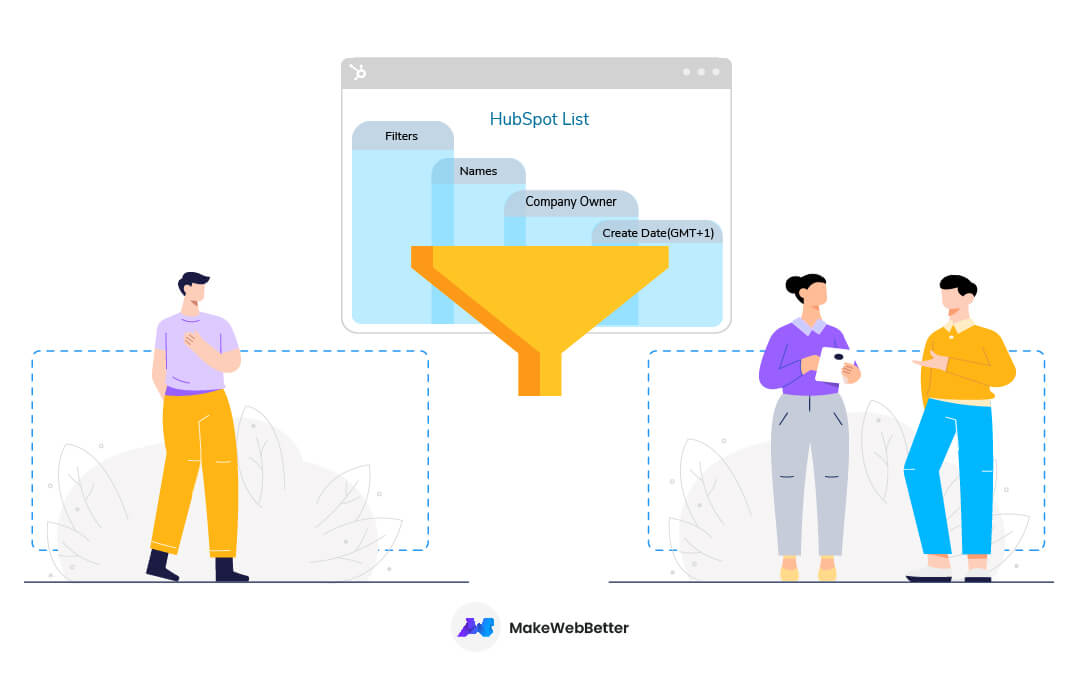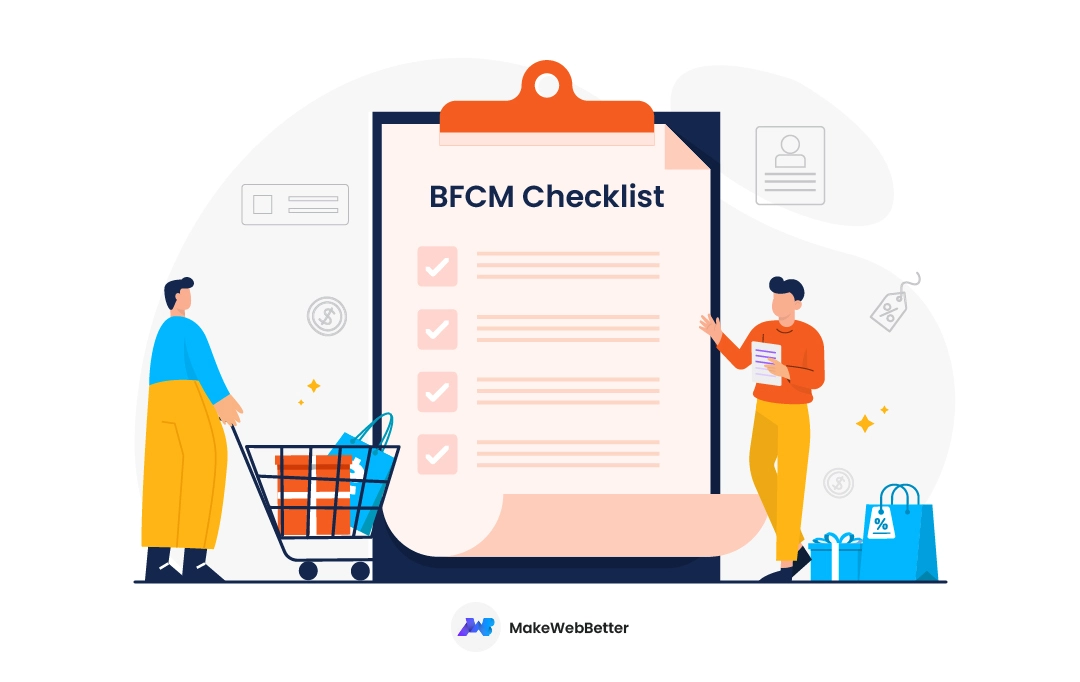How To Segment Your Contacts With HubSpot List Segmentation?
Every business is boarding the personalization bandwagon these days.
That’s because
- 80% of users are more likely to purchase from a brand offering a personalized experience.
- 72% of users only engage with personalized messaging.
- 42% of users find non-personalized content frustrating.
These numbers show how personalization can help your business. But how do you achieve it?
Well, if you use HubSpot(which I’m pretty sure you do. That’s why you’re here) you can do it easily through HubSpot segments.
Let’s cut to the chase and jump right into it.
What Are HubSpot Lists?

HubSpot List is simply a list of your HubSpot contacts or companies sharing similar characteristics.
For example, you want to create a list having data of all the companies located in the USA. To do this, you can create a list named “USA Companies” and set filters to enroll companies located in the USA.
This logic will enroll contacts in that list so you can create marketing campaigns accordingly.
We’ll talk later about how to create lists and add enrollment criteria in it to this post.
Level up your HubSpot segmentation game
Get a free consultation with our experts on HubSpot lists for easy yet powerful segmentation.
Types of HubSpot Lists
HubSpot allows you to create two different lists: Active and Static.
Let’s talk more about this to know what they are, how they function, and how they differ from each other.
-
Active List
Active lists are dynamic lists that automatically enroll/unenroll records from them whenever a record fits/doesn’t fit in the set criteria.
You can simply consider them as a list where you just need to set the filters and do not require any manual effort to maintain them.
Active lists automatically add and remove contacts, based on the criteria you set.
Use Case of Active List
Think you use HubSpot and want to divide your contacts as per their lifecycle stages.
Here, you can create a list that only enrolls a contact based on their specific lifecycle stage, let’s say Lead.
Once you create a list and add the filter, all the contacts with lifecycle stage Lead will enroll in it. Moreover, if the status of any contact changes from Lead to something else like Customer, the contact will unenroll from the list.
-
Static List
Unlike Active List, Static List doesn’t enroll or unenroll records automatically. If you’re creating a Static List, add or remove the records manually from the list.
You can add filters here as well and once you do that, the record that meets those criteria will be added to the list. You need to save that list but after saving them, if you want to add or remove any records, you’ll need to update them manually.
Use Case of Static List
A use case for static lists is if you want to run a campaign to send a coupon code to your sleeping customers. You can create a static list to extract all the customers who didn’t purchase anything for a while.
Once you get the list, enroll them in a workflow and send your coupons.
Let’s see how you can segment HubSpot contacts.
How to Perform HubSpot List Segmentation?

I’ve divided HubSpot list segmentation into 3 distinct steps. Let’s look at them.
Create HubSpot List
- Log in to your HubSpot account.
- Navigate to Contacts > Lists and click on the Create List button.
- Select the type of records(or data) you want to add to your list, i.e., Contact-based records or Company-based records.
- Give a name to your list.
- Select the type of list you want to create, Active or Static.
- Click Next to proceed further.
Add Filters to List
- Click on the Add Filter button in the left panel.
- Select the filter accordingly. For example, if you want to extract the list of records whose company is located in the USA, select Company Properties, then select Country/Region and the USA in the Values (you can add multiple filters in a list if you want).
- After adding the filters, the eligible contacts would appear on the right side.
- If you’re fine with the list, you can click the Save button on the top right to save the list.
Test Your List
Last, you can test your HubSpot list to check if it enrolled the right contacts in it or not. For that, you’ll see a Test button in the left panel.
Once you click it, a search bar will appear asking you to search for any contact. Search the contacts to make sure the right contacts are there in your list.
You’ve created your HubSpot list with filtered contacts. You can use this list now in your workflows, campaigns, etc. for precise targeting.
Not sure how to segment contacts in HubSpot?
Let our HubSpot experts guide you on the best HubSpot segments you can make.
7 HubSpot Lists You Must Create
If you want to level up your HubSpot list segmentation game, here are some lists you must create in your HubSpot portal.
-
Loyal Customers/Top Spenders
Loyal customers or top spenders are your low-hanging fruits.
Reports found that the probability of selling to an existing customer is up to 70% while the same number for a new prospect is 5-20%.
So if you focus on your existing/loyal customers or high-spending customers, you’ll make more with little effort.
So create a list of Loyal customers, and a HubSpot segment them based on their spending value, buying frequency, etc. Once you get the list, target them with your most alluring offers.
-
Subscribers
Subscribers are the members of your website who’ve opted-in for your blogs or newsletters.
Creating a list for your subscribers makes it easy to nurture users who’ve already shown their interest in your brand.
Such lists will help you send them resources like blogs, emails, gated content, etc. to eventually turn these subscribers into customers.
-
Ideal Buyer Persona
Every business has an ideal buyer persona that represents your ideal customers.
If you have mapped out your ideal buyer persona, it’s recommended to create a list for those personas.
This list will contain the contacts who can be your ideal customers. You can filter them based on their job profile, demographics, location, or any other aspect.
Creating a list for your ideal buyer persona would enable you to create super-targeting content since you already know their needs. And when you deliver content they need, they’re more likely to engage and convert.
-
Competitors
Many businesses find this unusual, but having a competitor list can help you well in your business. You may not pitch your content to your competitors, but having a list of them will help you keep track of their activities like what they’re doing to attract, close, and delight customers.
That’ll work as a helping hand to develop better strategies that put you ahead in the market.
-
Lifecycle Stage
Lifecycle Stages help you identify where a contact is in her buyer’s journey. By default, HubSpot comes with these lifecycle stages:
- Subscriber
- Lead
- MQL
- SQL
- Opportunity
- Customer
- Evangelist
Creating lists for all these stages can be a good decision, as it’ll help deliver the right content to the right person at the right time.
Like for Subscribers, you can deliver blogs that generate awareness while for Opportunity, a product demo would work better.
-
Cart Abandoners
Abandoned carts account for a loss of $18 billion annually for eCommerce brands.
But the good news is that recovering these carts is also possible. And HubSpot list segmentation makes it pretty easy. You can create a list that’ll enroll contacts whenever they abandon their cart.
You can then create an abandoned cart recovery workflow and use this list there. The workflow can remind users that they’ve product(s) added to their cart through a personalized email.
This email can contain a link to their cart, so if a user clicks on the URL, they’ll be redirected to their cart to complete their purchase.
-
Unsubscribed
It hurts when someone unsubscribes. But it’s a harsh reality.
However, instead of getting disappointed start maintaining a list of those unsubscribers as well.
Maintaining a list of these contacts will help you identify the reasons that made them opt out of your services so you can fix those bottlenecks in the future.
Keep in mind that this list will work as a problem-identifier. You should better not send any marketing emails to the users who’ve opted out of all your services.
Benefits of HubSpot List Segmentation
Let’s see how beneficial HubSpot list segmentation is for your business.
-
Customer-focused Marketing
Creating HubSpot contact segments gives you a better idea about the customer’s journey and their needs. And when you know what a user wants, you can deliver it better.
So when you use HubSpot list segmentation, you get a clear picture of your users’ needs. Hence, it gets easy for you to make strategies that’ll deliver better results.
-
Easier Customer Retention
A HubSpot report found that a mere 5% increase in customer retention can give a hike your profits by 25% to 95%.
And retaining customers is one of the major purposes HubSpot contact segmentation serves. With HubSpot list segmentation, you can craft a tailored customer experience using personalized content, better customer service, and more.
This makes your customers loyal to your brand and lets you retain them with ease.
-
Better Use of Resources
Another aspect of HubSpot list segmentation helps you in using your resources better.
When you know where your customers are in their buyer’s journey, you can deliver the resources that’ll drive them further in the funnel.
For example, if you’ve generated blogs for every stage of the buyer’s journey but are not sure who’ll engage most with it, you can divide your subscribers as per their stages. Then you can send the right type of content to the right audience so no content goes unread.
-
Improved Campaign Results
Delivering the right content at the right time to the right people have a higher chance of conversions.
And HubSpot contact segments help you with that.
After segmenting your contacts, you can craft campaigns that build for the users keeping their needs in mind.
Like for users in the early stages of their buyer’s journey, you can run awareness campaigns about your product. These campaigns will explain the benefits of your products and how they can make their life easier.
These campaigns will educate your users and move them ahead on their journey.
Final Words
Before starting any marketing campaign, it is critical to analyze your customer’s buying habits. To do this, lists are the best medium to divide your customer base on common traits.
With HubSpot list segmentation, you can send customized messages to your audience, engage them in your business, and work smart.
If you’re not sure how to start creating HubSpot contact segments, reaching out to us can be a splendid choice. As a HubSpot diamond solutions partner, we’ve helped hundreds of businesses to make the most out of HubSpot.
Squeeze Maximum Value with HubSpot
Get an expert that helps you unlock your HubSpot’s potential to the max.











Great Article, Amazing Information.
Thank You so much for sharing your knowledge.
Good to hear that you liked the post. Keep coming for more:)